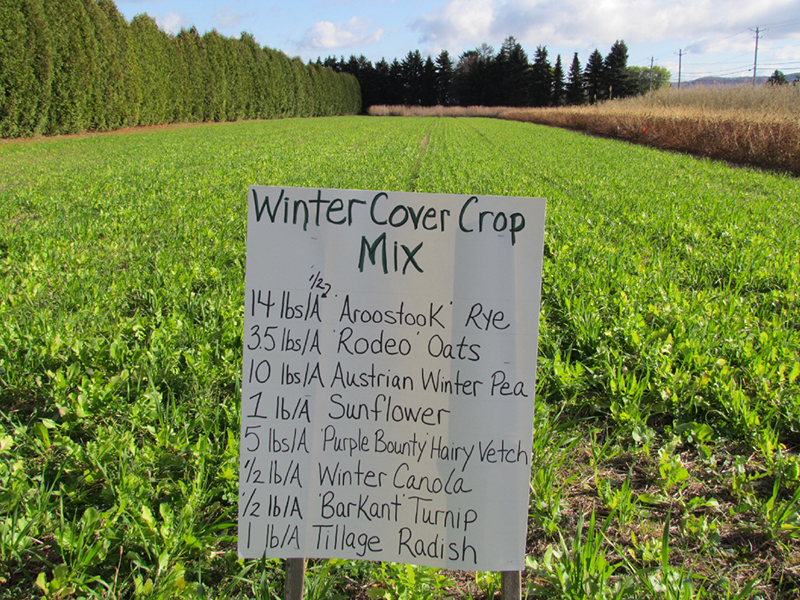
Cover Crops Are Good for the Bottom Line
by Sheryl Karas, CRA staff

Photo provided courtesy of the NRCS
The USDA and SARE (Sustainable Agriculture Research & Education) recently published a report on the economics of cover crops to help farmers decide when it would make sense to use this approach on their farms. The report(opens in new window) was based on five years of national cover crop surveys and addresses what economic returns can be expected under various management scenarios and as cover crops improve soil health over time. The report shows that while there is no one-size-fits-all answer to farmer concerns, when cover crops are seen as an investment rather than a cost, the benefits are significant.
According to the report, cover crops do improve commodity yields over time and often reduce input costs. This is especially true as farmers gain experience with what works best for their specific situations and the soil is improved. However, there were many cases where cover crops increased profitability within just a year or two. For example, when herbicide-resistant weeds are a significant problem, or when cover crops are grazed with fencing and water already available, the choice can be profitable the very first year. When used to address soil compaction, cover crops can provide a profit by the second year.
The report includes data from fields followed over time and for many of the farmers surveyed the results improved exponentially year by year. For example, it was found that average corn yields increased 0.5% after one year of cover crop use and soybean yields increased 2.1%. In those same fields, after two years, corn yields increased 1.8% and soybeans yields 3.5%. After five years, corn yields increased 3% and soybean yields 5%.
There was also encouraging data about the importance of cover crops in the case of drought. In the drought year of 2012, cover cropping provided a large boost in yield for the majority of farmers participating in the survey. Corn yields increased by 6% and soybeans by 11.4% after just one year of cover crop use. It is believed that those results were due to improved rainwater infiltration, reduced soil evaporation from cover crop residue, and changes to soil biology.
The Importance of Gaining Knowledge and Confidence
Report lead author Rob Myers, of the University of Missouri and North Central SARE, says that yield success seemed to be correlated with farmers gaining experience using cover crops and having their soil improved over time. The report explores seven common management situations to provide guidance but each farmer’s specific situation is unique and requires thoughtful progress and experimentation.
Gaining confidence and knowledge through taking safe risks is what several northern California farmers having success with this method repeatedly advised at a panel discussion on cover crops this week at Chico State. Colusa walnut farmer Daniel Unruh(opens in new window) joked that “we farmers are a fearful bunch” but “don’t let fear get in the way!” For him, experimenting with cover crops paid off the first year in addressing a nematode problem even when conventional wisdom was that it would not work. But he discovered that he had a 40% reduction in nematodes that first year and found no nematodes when his soil was tested most recently. Now he uses cover crops as much as possible because cost savings on inputs, especially nitrogen, have also been substantial. He reports spending only $800/acre with no need for added nitrogen. Walnut farming with conventional methods typically costs $1800-2500 an acre in his locale.
All the farmers on the panel suggested taking one small step at a time. Mark Biaggi, Ranch Manager at TomKat Ranch(opens in new window) in Pescadero, CA suggested starting small with 1-5 “safe to fail” zones so you can experiment without too much risk. The idea is to “do something different this year so your knowledge will be greater next year.” His ranch is transitioning rangelands to regenerative practices and he’s been pleased with the increase of organic carbon in the soil to aid in carbon sequestration and the ability to extend the growing season to eliminate the need to feed his grassfed cows expensive hay.
Rory Crowley of the Nicolaus Nut Company(opens in new window) in Durham, CA emphasized that cover crops are not just a technique for organic farmers. They have also been well worth it economically for his conventional orchards. Crowley started using cover crops to save money on water use. That was effective and now he is seeing decreased nitrogen fertilizer costs, and reduced soil erosion and displacement due to flooding. And, because bees are essential for pollination, he also likes that the cover crop provides a healthy bee habitat.
You can learn more about the economics of cover crops and download the full USDA-SARE report(opens in new window) for free.
